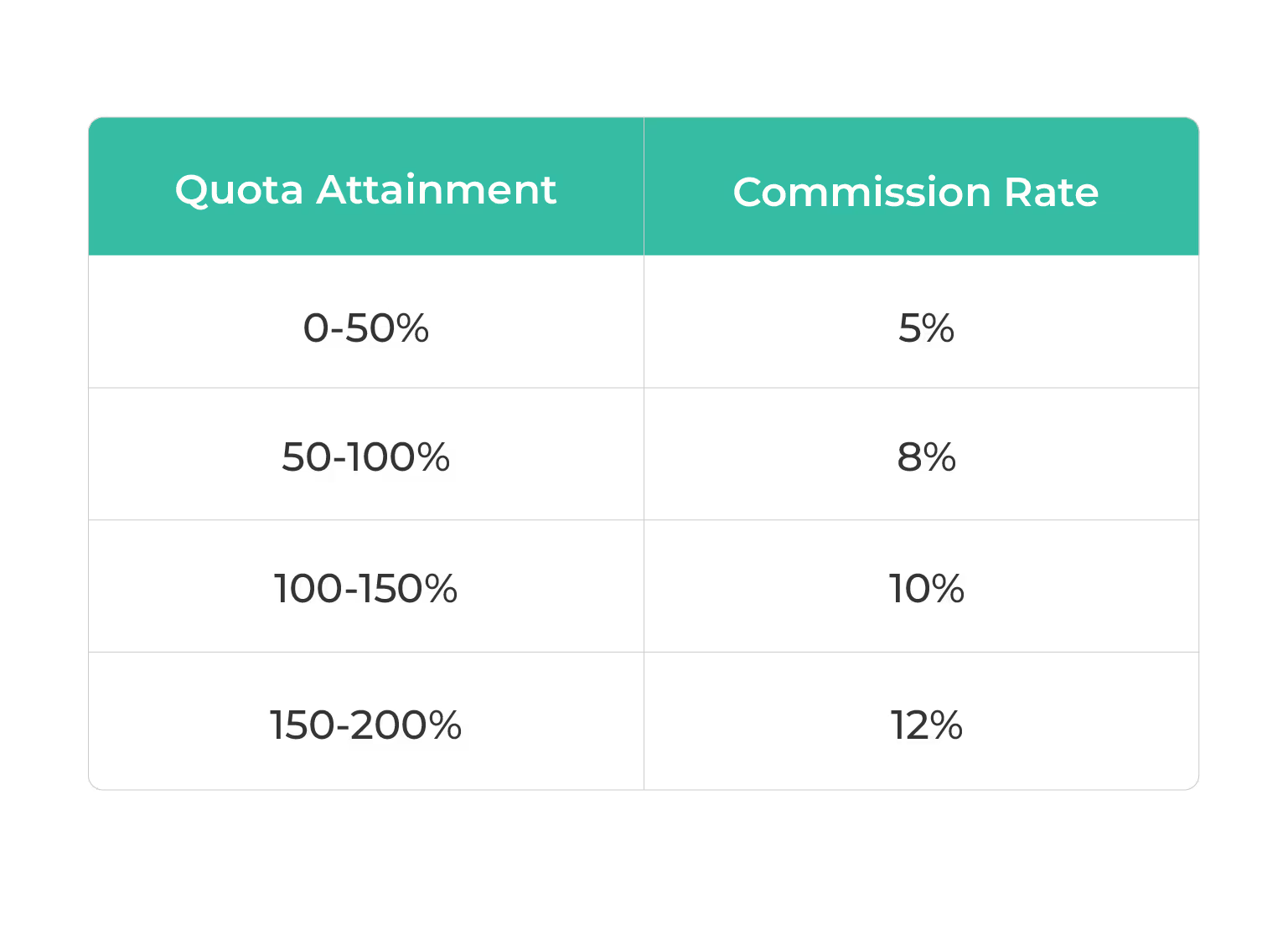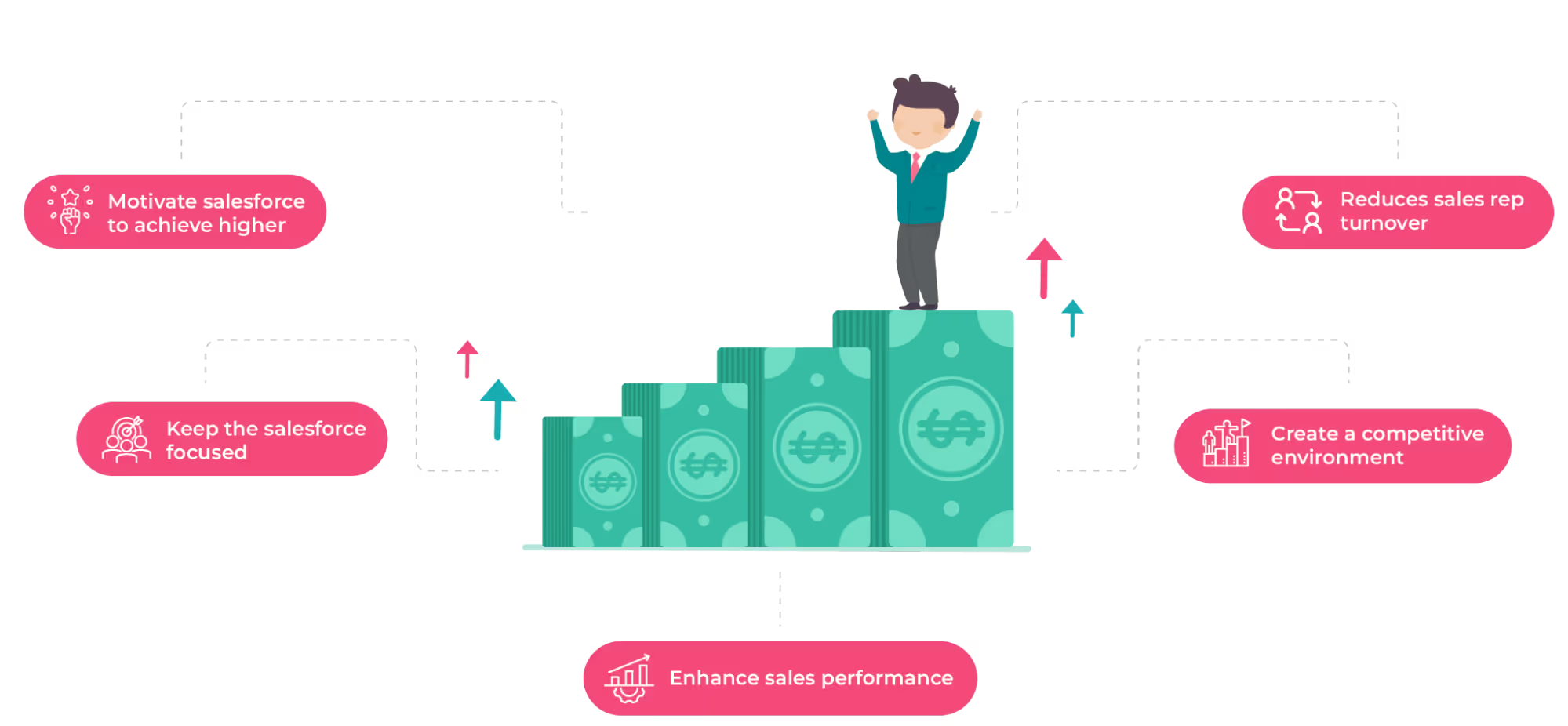
Blog
Benefits of Using a Tiered Commission Structure
September 1, 2023


Key Insights
In the book Freakonomics, Stephen J. Dubner and Steven Levitt wrote
An incentive is a bullet, a key: an often tiny object with astonishing power to change a situation
The statement points out how much power and potential the incentive tool holds in bringing change in your sales process.
With the immense possibilities and change that this ‘tiny object’ can bring about, how much have you explored its possibilities?
In this article we will deal with tiered commission structure, understanding it through examples and exploring the benefits it opens in your sales management.
Scroll down for me.
What is a Tiered Commission Structure?
A tiered commission structure offers different commission percentages depending on the milestones achieved by the sales rep. There is an incremental rise in the commission percentage as the quota attainment increases.
For example, within this sales commission structure, when the sales reps achieve within 50 percent of their quota, they will be eligible for a commission percentage of 5%, between 50-100 quota attainment, their incentives will be calculated with an 8% commission percentage, and this tiered approach continues to reward higher performance levels accordingly.
This form of SaaS sales commission structure will ensure that the salesforce is motivated, strives harder to achieve their quotas, and gains rewards and incentives.

Tiered Commission Structures Examples
Organizations implement tiered commissions in various ways.
The tiered commission examples can differ depending on the goals to be attained by the sales reps.
The usual sales commission goal, closely aligned with Commission Expense Accounting, is to bring a particular number of sales or revenue to the organization. This is calculated on an individual basis where the salesperson's personal sales achievements are evaluated while accurately accounting for the associated expenses and incentives.
Apart from this, the incentive can be calculated depending on the product they sell. For example, compared to other industries, selling a particular medicine will gain more pharma sales compensation than others.
Incentives can also be calculated based on the performance of the sales reps, with sales commission plan examples including accomplishing a set of tasks, maintaining quality in their sales journey, and ensuring customer satisfaction, among other key metrics evaluated by the salesforce.
Depending on the organization and its goals and objectives, a tiered commission structure will take one or more of these examples to build its incentive compensation structure.
Benefits of Tiered Commissions
Incentive compensation has a huge part in boosting sales performance and impacting the entire sales process.
Some of the benefits that a tiered commission structure offers include:

- Motivate sales reps to achieve higher
A sales team will have sales reps of varying caliber and potential. Some will be in the high-performing category while others will just be learning the basics. Tiered commission can ensure the motivation of sales reps across this performance spectrum. It can be the small but steady milestones to fun challenges depending on how each sales rep perceives their quota attainment.
- Keep the salesforce focused
ales quotes and incentives have always helped the salesforce to focus on their process. Having a proper sales commission structure helps sales reps plan their roadmap to achieving their goals and the company's desired objectives, thus directly supporting the overarching objectives of sales management, which include maximizing revenue, driving customer satisfaction, and ensuring sustainable growth.. A systematic approach helps in ensuring that there are enough leads in the pipeline to achieve the quotas and incentives.
- Enhance sales performance
The growth of an organization is very much dependent on the performance of its sales team. For this reason, organizations have always worked on upskilling them for better performance. A tiered commission structure enables sales performance as the salesforce has a clear picture of how much they must work towards achieving their goals and how much they can earn when they attain certain milestones. For a more detailed understanding, organizations often provide a commission report example, showcasing the breakdown and calculation methods used in their incentive structures.
- Create a competitive environment
A healthy competitive environment is always ideal for growth. A tiered incentive structure creates competition where the salesforce is not competing against anyone but themselves to improve their skills and attain higher goals. Self-competition is always ideal for better growth and performance than an unhealthy environment.
- Reduces sales rep turnover
When there is clarity in the tiered commission structure template, reps can themselves calculate to determine the possible commission amount they will achieve at the end of the quarter or year. This level of transparency and integrity will ensure trust and commitment from the employees thereby reducing sales rep turnover.
Building a well-structured commission plan, including elements such as non-recoverable draw commissions, will aid in the better management of the sales team and enhance their performance and productivity while providing financial stability to sales representatives during lean periods.
For further reading on sales commission structure, check 9 Best Sales Commission Structures for Maximum Performance.
Conclusion
Incentive compensation management, when done right, can yield all the benefits your organization aimed for. Implementing an effective incentive compensation management system ensures transparency, fairness, and alignment with business objectives, empowering your organization to drive performance and achieve strategic goals effectively.
Hence, companies must put effort and time into building an effective sales commission structure, seamlessly implementing it in their operations and efficiently managing to bring the positive desired outcomes.
Kennect assists organizations in achieving these goals through automation of your incentive compensation management and sales performance management. We build, run, and automate your incentive compensation plans to create transparency and achieve operational efficiency.
For more information, Book A Demo Today.
ReKennect : Stay ahead of the curve!
Subscribe to our bi-weekly newsletter packed with latest trends and insights on incentives.
Thank you! Your submission has been received!
Oops! Something went wrong while submitting the form.
Your data is in safe hands. Check out our Privacy policy for more info















